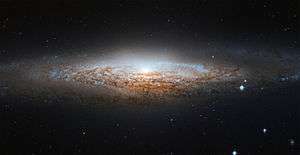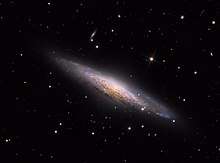NGC 2683
NGC 2683 is a field spiral galaxy discovered by William Herschel on February 5, 1788. It was nicknamed the "UFO Galaxy" by the Astronaut Memorial Planetarium and Observatory.[3][4]
| NGC 2683 | |
|---|---|
 NGC 2683, as taken by Hubble Space Telescope | |
| Observation data (J2000 epoch) | |
| Constellation | Lynx |
| Right ascension | 08h 52m 41.3s[1] |
| Declination | +33° 25′ 19″[1] |
| Redshift | 411 ± 1 km/s[1] |
| Distance | 25 ± 4 Mly (7.7 ± 1.3 Mpc)[2] |
| Apparent magnitude (V) | 10.6[1] |
| Characteristics | |
| Type | SA(rs)b[1] |
| Apparent size (V) | 9′.3 × 2′.2[1] |
| Other designations | |
| UGC 4641,[1] PGC 24930[1] | |
It is viewed nearly edge-on from Earth's location in space and is located between 16 and 25 million light-years away.
NGC 2683 is receding from Earth at 410 km/s (250 mi/s), and from the Galactic Center at 375 km/s (233 mi/s).[3]
Visibility
The reddened light from the center of the galaxy appears yellowish due to the intervening gas and dust located within the outer arms of NGC 2683.[5] Its apparent magnitude is 10.6 making it not visible to the human eye without the aid of a small telescope.
Characteristics

While usually considered an unbarred spiral galaxy, recent research suggests it may in fact be a barred spiral galaxy; its bar is hard to see due to its high inclination.[6] Further support for the presence of a bar stems from the X-shaped structure seen near its centre, which is thought to be associated with a buckling instability of a stellar bar.[7]
It is also both smaller and less luminous than the Milky Way with very little neutral hydrogen[8][9] or molecular hydrogen[9] and a low luminosity in the infrared, which suggests a currently low rate of star formation.[10]
NGC 2683 is rich in globular clusters, hosting about 300 of them, twice the number found in the Milky Way.[11]
Due to its vast distance and complexity (due to the association of Globular Clusters bound to it), NGC 2638's mass has not been calculated as accurately as it could be. Otherwise its volume and vector motions are reasonably well known and characterized.
References
- "NASA/IPAC Extragalactic Database". Results for NGC 2683. Retrieved 25 November 2006.
- J. L. Tonry; A. Dressler; J. P. Blakeslee; E. A. Ajhar; et al. (2001). "The SBF Survey of Galaxy Distances. IV. SBF Magnitudes, Colors, and Distances". Astrophysical Journal. 546 (2): 681–693. arXiv:astro-ph/0011223. Bibcode:2001ApJ...546..681T. doi:10.1086/318301.
- "NGC 2683". NGC Online. SEDS. Retrieved 4 February 2014.
- Materne, J. (April 1979). "The structure of nearby groups of galaxies - Quantitative membership probabilities". Astronomy and Astrophysics. 74 (2): 235–243. Bibcode:1979A&A....74..235M.
- Matthews, Doug; Block, Adam (15 November 2004). "Best of AOP: NGC 2683". Retrieved 12 October 2010.
- Kuzio de Naray, Rachel; Zagursky, Matthew J.; McGaugh, Stacy S. (2009). "Kinematic and Photometric Evidence for a Bar in NGC 2683". The Astronomical Journal. 138 (4): 1082–1089. arXiv:0908.0741. Bibcode:2009AJ....138.1082K. doi:10.1088/0004-6256/138/4/1082.
- Bogdan C. Ciambur; Alister W. Graham (2016), Quantifying the (X/peanut)-shaped structure in edge-on disc galaxies: length, strength, and nested peanuts
- Karachentsev, Igor D.; Karachentseva, Valentina E.; Huchtmeier, Walter K.; Makarov, Dmitry I. (2003). "A Catalog of Neighboring Galaxies". The Astronomical Journal. 127 (4): 2031–2068. Bibcode:2004AJ....127.2031K. doi:10.1086/382905.
- Bettoni, D.; Galletta, G.; García-Burillo, S. (2003). "A new catalogue of ISM content in normal galaxies". Astronomy and Astrophysics. 405: 5–14. arXiv:astro-ph/0304054. Bibcode:2003A&A...405....5B. doi:10.1051/0004-6361:20030557. Retrieved 2012-12-25.
- Pompei, E.; Terndrup, D. M. (1998). David R. Merritt; Monica Valluri; J. A. Sellwood (eds.). "The Stellar and Gaseous Kinematics of NGC 2683". Galaxy Dynamics, Proceedings of a Conference Held at Rutgers University, 8-12 Aug 1998. ASP Conference Series (San Francisco: ASP). 182: 221. Bibcode:1999ASPC..182..221P.
- "Globular Cluster Systems in Galaxies Beyond the Local Grup". NASA-IPAC Extragalactic Database (NED). Retrieved 2012-07-21.
External links
| Wikimedia Commons has media related to NGC 2683. |
- NGC 2683 on WikiSky: DSS2, SDSS, GALEX, IRAS, Hydrogen α, X-Ray, Astrophoto, Sky Map, Articles and images
- APOD, 5 Feb 2014